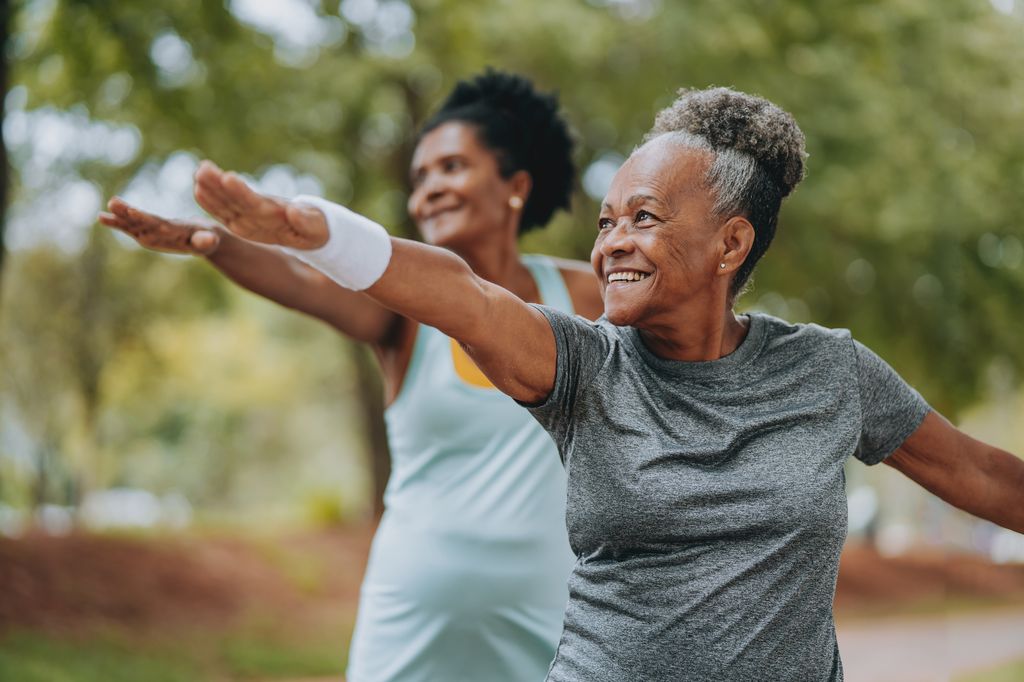Being able to hop off the sofa, spring out of bed in the morning and pop to the shops is something we all take for granted, but as we age, these once-easy things can become tricky.
This is due to our mobility, which can decline as we get older. The good news is, if we look after our mobility while we’re still young, we can stave off the decline and stay active well into our 60s and 70s.
“Staying active and supporting muscle and joint strength can make a big difference in helping us stay strong and independent for years to come,” says physiotherapist Fikri Fikriev, who works with Orchard Manor care home.
Why is mobility important?
“Having good mobility allows us to retain independence for longer, meaning we can safely complete tasks such as walking, cooking, using the bathroom and getting dressed,” says Jamila, who works at the care home in Surrey.
“Mobility is also tied to cognitive health, as it can affect how often you leave the house, and therefore your engagement and interaction with your external environment and other people. Keeping your independence depends on your mind and your body, so it’s important to do what you can to nourish both,” explains Jamila.
“We have residents who are nearly 100 who are out gardening or walking in the grounds nearly every day. Age is just a number – a lot of their mobility is testament to how they have looked after themselves over the course of their lives and how we support them to stay fit.”
On why our mobility takes a turn for the worse, Fikri, who works with Physiotherapy Matters, says: “As we age, naturally the joints can become stiffer, and our muscles lose strength.”
On how sharp the decline might be, Fikri continues: “The rate of muscle mass loss depends on age and lifestyle, but we gradually begin to lose muscle mass from around our 30s and 40s. This process can speed up between 65 and 80 years old. The rates vary; however, it can reach as high as 8% muscle mass loss per decade.
“This can have an effect on your mobility and energy levels, hence why it’s essential to have a balanced routine that helps to preserve strength and flexibility as we age.”
In our 40s and 50s
If you’re in midlife, the time is now to start safeguarding your mobility. Fikri explains: “The mistake most 40 and 50-year-olds make in regard to mobility is failing to perform regular stretching.
“This can be in the form of a full body exercise such as yoga or individual joint and muscle stretching.
“It is particularly important to dynamically stretch before exercise as part of a warm-up routine to reduce the risk of muscle strains, as well as post-exercise to reduce DOMS (delayed onset muscle soreness) and maintain muscle and joint mobility.”
Here, Fikri shares four pieces of advice to maintain mobility in midlife.
4 exercises to stay mobile, strong and independent as we age
“Perform the below exercises at least three or four times per week – consistency is key,” says Fikri. “Start nice and easy and progress gradually, and don’t forget to take regular breaks. Stay hydrated, increase protein intake in your diet with simple ingredients like eggs, and wear supportive and comfortable footwear.
“Always consult your GP, physiotherapist, or personal trainer if you have chronic conditions, limited mobility, injuries or if you are unsure how to progress/regress your exercise routine.”
1. Two-leg bridge for mobility
“Bridge exercises and hip thrusts can improve back pain, as well as hip, hamstring and glute strength. They also help with stretching the hip flexors that tend to get tighter with prolonged sitting,” says Fikri.
“Additionally, bridge exercises can help strengthen the core and pelvic floor. This is very important, especially in people who struggle with bladder control.
“After the basic bridge, you can progress towards single-leg bridge, or even further into hip thrusts (with or without weights). There are lots of bridge and hip thrust variations to pick from.”
2. Wall push-ups
“Push-up exercises are a great way to improve posture and upper body strength, such as in your back, chest, and core. They also help to improve heart health, lose body weight and fat, and lower blood pressure and cholesterol.
“You can progress towards an incline push-up on a countertop or table, then to a higher difficulty with push-ups on the floor,” says Fikri.
3. Sit to stand/squat
“Sit-to-stand exercises, squats and lunges are important functional exercises to improve the ability to do daily activities and maintain independence. This includes sitting down or standing up, climbing stairs, and improving balance and strength in the lower body, “says Fikri.
“From sitting to standing exercises, you can progress towards squats (with or without support), and then further difficulty lunges (with or without weights).”
4. Calf raises
“Calf raises offer several benefits, including improved balance, increased ankle stability and mobility, and enhanced strength. They also improve lower limb blood circulation, which reduces sprains and helps prevent falls.
“Moreover, calf raises increase Achilles tendon resilience, which can reduce the risk of tendinopathy, which can have a negative impact on walking and running. You can then progress towards single calf raises, and into jumping calf raises (plyometric). All can be done with or without additional weights.”
Read the full article here









